The Celts and Nature
The Celts, along with most ancient peoples, had a great respect for nature. The effects of the natural world determined whether they lived or died. If the weather was bad and the growing season suffered, they risked starvation. Natural disasters could make wild animals become dangerous enemies as well because the animals’ own starvation made them desperate enough to risk attacking humans. If the winter was exceptionally cold, the Celts risked freezing to death unless they had shelter that was safe and warm. For heat, they needed firewood, which came from the huge forests all around. So their relationship with nature was a part of their everyday life.
More urban cultures like Greece and Rome organized their societies around city-states. Because they were country people, the Celtic civilizations organized theirs around the land. Their relationship to the land was very important. Changes in the land and weather were watched very carefully and interpreted for the kings by druids. Their traditions preserved the knowledge of how to live on the land through the changes of time, season, and weather. For this reason, even though they were defeated by the Roman army and eventually converted to Christianity, these peoples of the northern forests kept alive many of their customs, their land-based religion, and their unwritten seasonal calendars, even to the present day.
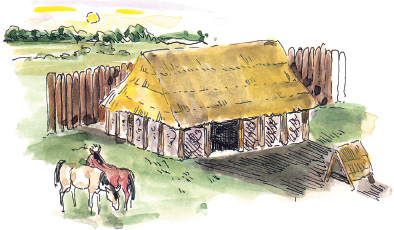
Dwellings were made of rushes, wood, stone, and some form of mud
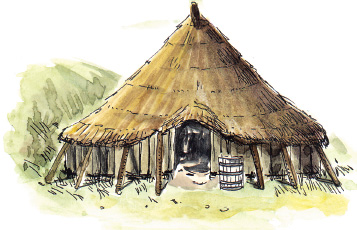
Celtic dwellings in Britain, Spain, and Portugal were usually round, while in other areas of Europe they were square or oblong
Water was very important to all the ancient people. The Romans were the first to make aqueducts to carry water from one place to another. Before that, farmers had to use different ways to irrigate their crops. Drinking water had to come from clean rivers, springs, and wells. And indeed, rivers, springs, and wells are featured in many traditional Celtic stories. As these places were so important to the Celts’ survival, they were considered sacred. The stories tell of gods and goddesses who became rivers or springs and of the guardians who protected them. Many rivers in Celtic countries are named after these same gods and goddesses. Special healing was available at many of the springs and wells. People with health problems would go bathe in the spring or drink water from the well. Then they tied colored ribbons on nearby trees as thanks for the healing they received.
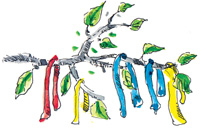
Because they worked with the forces of nature, the druids never built temples or churches. It was perfectly appropriate for them to hold their religious services in the open, natural world. They performed their rituals in sacred groves—special groups of trees that held deep meaning for their tribes. As all life was sacred to them, they did not make statues of their gods and goddesses. If the goddess was embodied by the river, there was no need to make a statue of her that looked like a human. This nature-based view was very different from the way the Greeks and Romans looked at their gods and goddesses.
But one thing the Celts did have in common with the Greeks and Romans was that all three cultures were fond of telling stories about their gods, goddesses, heroes, and heroines. Many of the stories from the Irish Book of Invasions, for example, are about the Tuatha De Danaan (the Children of Dana). These are stories of great battles, fought by mighty heroes. The Tuatha De Danaan are actually ancient Celtic gods and goddesses. Celtic tales also include many great heroes, like Cuchulainn, who is like an Irish Hercules.
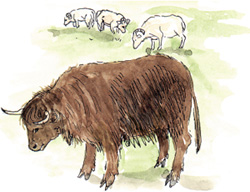
Animals always played a great part in Celtic life. The Celts raised animals like oxen to use for labor and sheep, goats, and pigs for food and wool or hides. They used horses for battle. In their stories, great adventures are centered around cattle raids, herds of swine, and hunts for mysterious white stags. Another common theme in adventure stories was one kingdom’s stealing of rare animals from another kingdom.
Many of the gods and goddesses were known by the animals they were associated with, like Cerridwen, the Welsh goddess who is associated with a white sow, or Rhiannon, another Welsh goddess who is associated with a white horse. These special animals are called “totem animals.” The god Bran (or Vran) was a great hero and adventurer. His name means “raven.” When he was killed in battle, his head continued to live and talk. He asked his men to bury his head on the White Mount in what is now London. Here he would guard and protect England until his head was dug up. Legend has it that King Arthur dug Bran’s head up because he wanted to be the only hero responsible for England’s welfare. Nowadays, there are actual ravens in the Tower of London and it is said that when the ravens leave the tower, England will fall.

Many heroes are associated with an animal that was born at the same time they were. Sometimes the human and the animal are raised together. Sometimes the association with a totem animal comes later, at an important event in the hero’s life. The name of the great hero Cuchulainn means “hound of Culann.” His name at birth was Setanta. He got the name Cuchulainn by fighting and killing the guard dog of the chief he served, then offering to become the guard dog himself, until a new one could be found. From that point on, eating dog meat was forbidden to him. In Celtic tradition, heroes are usually given a series of things they must never do. These prohibitions are called geasas.
The tradition of human association with a special totem animal carried on through the Dark Ages, when the early Celtic Christian Church was at its strongest. Many of the Saints, who helped spread the Church throughout England, Ireland, and Scotland were associated with birds, otters, dogs, and horses and are still shown with these animals in pictures today. Saint Kevin is always pictured with blackbirds, Saint Maedoc is associated with the stag, and Saint Kentigern with a salmon.
The alphabet the druids used was also tied to nature. Although the druids did not write anything down, there are carvings on stones in northern Europe that use a special alphabet called ogham. They appear to have been carved from around A.D. 300 on. The alphabet is different from our ABCs. The names of the letters refer to the Irish names of plants or animals. For example, in tree ogham the letters represented the names of trees. In bird ogham the Celts used the same order of letters (which started B, L, N, F, S, not A, B, C, D, E!) but instead of representing the names of trees, the letters represented the names of birds. We know about this alphabet from the later writings of bards and storytellers who did write things down. There are many types of ogham mentioned in their poems and stories and most of them refer to things in the natural world.
Much of what we know of the later Celtic cultures comes from Irish texts and some Welsh texts, all written down much later, but containing within them elements of the original storytelling traditions of the Celtic past. When we look at French and British Celtic culture, we divide it into the time before the Romans invaded, the time when the Romans ruled, and the time after they were driven out. The Romans had a very strong influence on all the countries they had contact with. Later the Angles, the Saxons, and the Jutes invaded Britain, as did the Vikings, all leaving their influences on the culture. And, just as with any culture today, some Celtic societies were rich and some were poor. So, you see, it can be misleading to make generalized statements about all the Celts at once. But we can safely say that all the Celts had a close relationship with nature.
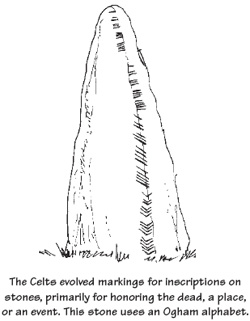
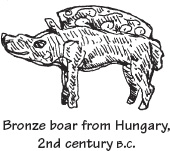
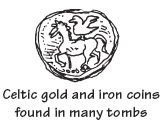
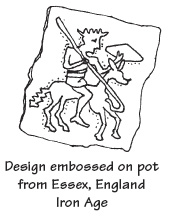
A way of learning about the early Celts is from objects found in burial sites throughout Europe